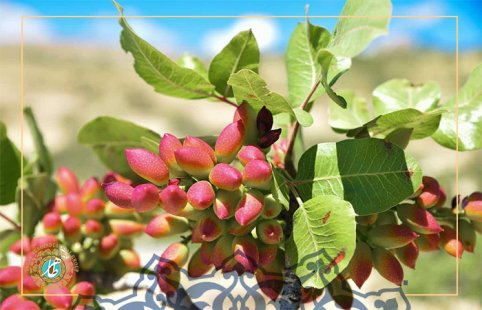
Maybe you would like to know when and how the pistachio seedlings that you bought at a high cost and spent years of energy and resources will bear fruit? Or maybe these questions also arise in your mind that what should we do to bear fruit on our pistachio tree? What can we do to speed up the fruiting of the pistachio tree? Or what is the best type of pistachio graft base? What can we do to have a good product in the future?
And most importantly, how old is the pistachio tree?
Basically, the pistachio tree begins to produce pistachio after 7 to 9 years after planting seedlings and transplanting .Those who intends to build a pistachio orchard must be a little patient to make an economic profit. Pistachio orchards are usually forest-shaped (artificial forest) and fresh pistachio clusters appear on the branches of pistachio trees. Usually in September, pistachios are harvested every year. As you know, the best soil for growing a pistachio tree is a mixture of sand and clay, which causes better growth and thus makes the pistachio bear fruit sooner.
How can our tree bear fruit sooner than scheduled?
In fact, if we want to get products from the seedlings we have planted or we want these beautiful pistachio seedlings to bear fruit as soon as possible, we must pay attention to something.
Climate suitable for pistachio planting
Knowing the climate and the right climate for the pistachio tree is a vital factor before building a garden, to invest in a pistachio tree or any other product, it is important to be familiar with the climate that is suitable for the tree so that we do not have problems later. As we know, climate change varies considerably. This has made most of the climates on Earth that used to be suitable for a fruit or tree not work at all today.
In fact, the pistachio tree likes hot and dry climates with low humidity. In humid weather, pistachio trees do not bear good fruit but will grow.
Suitable climatic conditions for planting pistachio seedlings are hot and dry climate in summer (not hot heat) and cold and temperate In winter .
In fact, the best climate for growing pistachios is a desert climate with a low temperature.
Botanical characteristics of pistachio tree
The pistachio tree is a plant with two bases, namely male and female flowers, separated from each other and placed on a separate tree. The inflorescence of the pistachio tree is generally clustered and in the male cluster the flowers are compact and dense. There are more flowers than in the female cluster where the distance between the flowers is large and therefore these types of flowers are clustered and loose.
Female flowers have one ovary and one egg, but the stigma is branched and has three branches. The leaves of the pistachio tree consist of 5 to 7 leaflets. The root of the tree is axial and vertical and sinks into the soil to a depth of more than two meters. Female flowers are inoculated by wind
Favorable weather for pistachios
Pistachio tree is both resistant to extreme winter cold and high summer heat. Pistachio tree is not compatible with humid air and soil. High humidity in the ground causes Gummosis Disease and rot on the tree collar, which gradually weakens the tree and eventually dries it out. Pistachio tree is very resistant to water shortage and drought so that old trees can be kept alive for a very long time (happiness for several decades) without irrigation.
Optimal soil for pistachios
The best soils for planting pistachio trees are light lemon soils, ie sand and clay. In light lands, fertilizer application is satisfactory for harvesting, but in heavy clay lands that retain a large amount of moisture for a long time, planting this plant does not give satisfactory results and the yield will not be very significant. Pistachio tree tolerates soil salinity to some extent.
-
A) Irrigation
Although pistachio is very resistant to dehydration, it should not be neglected, especially at an early age. On average, depending on the soil texture, the following irrigation circuit maintenance is recommended depending on the age of the tree: (except winter)
Tree aged 1 to 3 years: Irrigation circuit 7 to 10 days
Tree aged 3 to 6 years: Irrigation circuit 12 to 20 days
Tree aged 6 years and older: One month irrigation circuit
It should be noted that when the irrigation cycle is one month, a lot of water should be given to the tree in each irrigation so that moisture can penetrate completely into the soil.
-
B) Pruning
Pruning means cutting the extra branches and this operation is done in winter. After the tree is formed in the years after transplanting and before fruiting, pruning is important, which includes pruning the branches, uprooting and removing the cuttings.
Pruning causes the fruit of the tree to grow large and the fruiting to be somewhat uniform in different years.
-
C) Fertilization
The sheep and cattle manure used must be completely rotten. It is better to mix chicken manure with sheep or cow manure and bury it in a furrow at a depth of at least 40 cm depending on the age of the tree and 40 cm wide at the end of the tree canopy. Fertilizing season is the dormant season of trees, ie winter.
Mixing complete chemical fertilizer (N-p-K) with animal manure is also desirable.
Applying nitrogen fertilizer (ammonium sulfate and potassium sulfate) in areas with saline soil and water in the second half of May to increase vegetative and reproductive buds, in the second half of July to fill pistachio seeds in fruit trees is appropriate.
The amount of fertilizer used with expert advice is from 100 grams to 200 grams per tree.
The use of liquid and solid micro fertilizers in the tree growing season, depending on the type of deficiency and consultation with agricultural experts simultaneously with spraying or independently is very appropriate. After harvesting pistachios, it is recommended to apply zinc fertilizer as a foliar application.






User comments